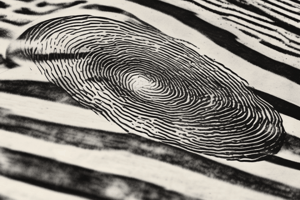Podcast
Questions and Answers
Which field focuses on analyzing the marks left by tools at a crime scene?
Which field focuses on analyzing the marks left by tools at a crime scene?
- Forensic Anthropology
- Toolmarks (correct)
- Pathology
- Odontology
What is the primary responsibility of a forensic specialist in the field of Pathology?
What is the primary responsibility of a forensic specialist in the field of Pathology?
- Analyzing blood spatter patterns
- Examine ammunition and gunpowder
- Studying human remains
- Investigating the cause and manner of death (correct)
Which type of evidence includes oral or written statements from witnesses?
Which type of evidence includes oral or written statements from witnesses?
- Physical Evidence
- Circumstantial Evidence
- Documentary Evidence
- Testimonial Evidence (correct)
In forensics, what role does a bloodstain pattern analyst fulfill?
In forensics, what role does a bloodstain pattern analyst fulfill?
What is the study of insects called, which can help determine the time of death in forensics?
What is the study of insects called, which can help determine the time of death in forensics?
What term describes evidence that can be easily changed or lost at a crime scene?
What term describes evidence that can be easily changed or lost at a crime scene?
Which of the following is considered pattern evidence?
Which of the following is considered pattern evidence?
What type of evidence identifies a particular person or object?
What type of evidence identifies a particular person or object?
Which type of evidence can be linked only with a group of items that share characteristics?
Which type of evidence can be linked only with a group of items that share characteristics?
What type of evidence is represented by a statement made under oath?
What type of evidence is represented by a statement made under oath?
Which type of evidence is produced through direct contact between individuals or objects?
Which type of evidence is produced through direct contact between individuals or objects?
Which of the following is an example of biological evidence?
Which of the following is an example of biological evidence?
What is the primary goal of evidence collection at a crime scene?
What is the primary goal of evidence collection at a crime scene?
Which term refers to scientists who analyze body fluids for criminal clues?
Which term refers to scientists who analyze body fluids for criminal clues?
What role do psychologists play in forensic investigations?
What role do psychologists play in forensic investigations?
In the crime scene protocol, what is the second step?
In the crime scene protocol, what is the second step?
Which type of forensic investigator analyzes digital media?
Which type of forensic investigator analyzes digital media?
What does CODIS stand for?
What does CODIS stand for?
What is the last step of the crime scene protocol?
What is the last step of the crime scene protocol?
Which term describes a person suspected of aiding in committing a crime?
Which term describes a person suspected of aiding in committing a crime?
What does the term 'latent' refer to in forensic science?
What does the term 'latent' refer to in forensic science?
Which is the primary objective of a crime scene investigation?
Which is the primary objective of a crime scene investigation?
What does Locard's Principle state?
What does Locard's Principle state?
Which of the following is not classified as circumstantial evidence?
Which of the following is not classified as circumstantial evidence?
What type of evidence can establish a link between a suspect and a crime based on unique characteristics?
What type of evidence can establish a link between a suspect and a crime based on unique characteristics?
Which option is an example of trace evidence?
Which option is an example of trace evidence?
Hair or body fluids collected at a crime scene would be categorized as what type of evidence?
Hair or body fluids collected at a crime scene would be categorized as what type of evidence?
The chain of custody in evidence handling ensures what?
The chain of custody in evidence handling ensures what?
Which statement about physical evidence is accurate?
Which statement about physical evidence is accurate?
Flashcards are hidden until you start studying
Study Notes
Crime Scene Protocol
- The first step is to interview witnesses and victims
- Second, examine the scene
- Third, document findings with sketches and photographs
- The last step is to collect evidence using the correct techniques
Evidence Types
- Physical evidence can be either testimonial or physical
- Examples of testimonial evidence: Grand jury testimony, Statements given in response to police interrogation
- Examples of physical evidence:
- Blood, semen, and saliva
- Documents
- Drugs
- Explosives
- Fibers
- Fingerprints
Evidence Types (cont.)
- Transient evidence is temporary and can be easily lost
- Pattern evidence is produced by a direct contact between people or objects
- Conditional evidence is the result of a specific event or action
- Associative evidence links a victim or suspect to a scene
Evidence Classifications
- Individual evidence can identify a specific person or thing
- Class evidence can identify a group that shares similar properties or characteristics
- Chemical evidence includes elements that may be found on a victim, a suspect, or at a crime scene
- Items that may associate a victim or suspect with a scene or each other; ie, personal belongings
- Biological evidence includes body fluids, hair, plant parts, natural fibers
Locard's Principle
- States that every contact leaves a trace
Key Terms
- Serologists test bodily fluids to find clues
- Latent print specialists identify fingerprints, footprints, and palmprints
- CODIS is a database of DNA profiles from suspects and crimes
- Botany is the study of plants, which can be used to identify location information
- Toxicologists test body fluids to find drugs or poison
- Forensic Psychologists study the mind and human behavior to provide clues about crimes
- Forensic Physics is applied to crime scene investigation to analyze forces and motion
- Computer forensic investigators specialize in digital evidence and cybercrime
- DNA profiling identifies individuals by their unique genetic makeup
- Suspect is someone thought to have committed a crime
- Accomplice is someone believed to have assisted in a crime
- Alibi is the statement a suspect provides that explains their whereabouts at the time of a crime
- Crime scene is the location of a crime
- Secondary crime scene is the location of additional evidence related to the original crime scene
- Facial composite is a sketch of a person’s face
- Physical evidence is a material item that can be tested
- Polygraph is a lie detector
Evidence Collection
- The primary goal of evidence collection is to document, recognize, and collect evidence that may be relevant to a crime
- Chain of custody tracks evidence from collection to presentation in court
True or False
- True: Physical evidence includes items present at a crime scene or on a victim
- False: Class evidence does not narrow the identity to one specific individual
- True: Biological evidence is often placed in a paper bindle
- True: Direct evidence directly proves a fact without inference
- True: Law enforcement and specialists may be involved in a CSI team
Studying That Suits You
Use AI to generate personalized quizzes and flashcards to suit your learning preferences.




